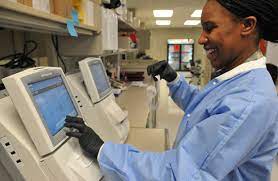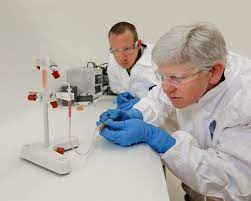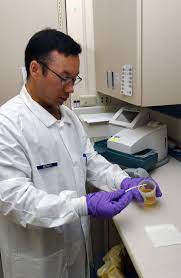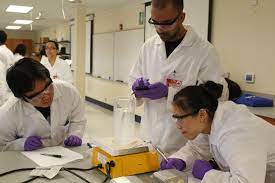Identification Of Late Onset Hypogonadism In Middle Aged And Elderly Men
Identification of Late-Onset Hypogonadism in Middle-Aged and Elderly Men
There is disagreement among professionals in the medical community regarding the clinical significance of the age-related decline of Male Testosterone Levels. As a result of this uncertainty about the nature of Low Testosterone and the aging man, guidelines have been updated suggesting that Adult-Onset Hypogonadism be regarded as a quantifiable medical condition that occurs as a result of changes in biochemistry that occur during the aging process.
A slate of specific symptoms now characterizes Adult-Onset Hypogonadism, and the diagnosis of this syndrome results from clinically low Testosterone Levels combined with the experience of those symptoms.
The problem is that since Adult-Onset Hypogonadism has only recently been fully quantified as a medical disorder, there is a lack of clinical data which considers Testosterone Deficiency instead of all the symptoms that have now been scientifically linked to Low T.
Data is exceedingly slim among patients who suffer from this form of natural Testosterone Deficiency rather than a pathological form of Testosterone decline, which is not directly correlated with age.
Testosterone Deficiency Linked to Many Disorders
Even though there is a well-known list of symptoms associated with a severe deficiency of Testosterone in younger males, the symptoms displayed in older men are not specific only to Low Testosterone. Many other relatively common disorders can produce many similar symptoms.
Low Testosterone in younger patients is less than 6 to 8 nanomolar per liter. Because of the large gray area in which Adult-Onset Hypogonadism shares many symptoms with other disorders, the exact Testosterone levels associated with Testosterone Deficiency and the precise adverse health risks associated with the disorder are not well delineated.
At this point, the threshold for Low-Testosterone is relatively arbitrary, and there is a movement to discover this threshold with greater accuracy.
The participants of this study come entirely from two age groups. The first group of patients is middle-aged, and the second group is elderly. The study's goal was to characterize the medical symptoms related to Testosterone Deficiency and to distinguish the various thresholds associated with different levels of symptomatic severity.
The ultimate goal of the study was to demarcate a more exact set of criteria for the diagnosis of Adult-Onset Hypogonadism based on the experience of symptoms and their severity and various rates of Testosterone Deficiency.
Testosterone Research Methods
Participant Pool

In this study, the researchers selected a random assortment of men to investigate, organized by age. These men were participants in a study known as the European Male Aging Study (EMAS). This clinical study involved eight different medical centers across Europe. Individual cases were selected from clinics in Spain, Italy, Hungary, Poland, Estonia, Sweden, Belgium, and the United Kingdom.
The participants in this investigation ranged from forty to seventy-nine years of age. Each participant selected for the EMAS study was tested in a number of different ways.
Each patient completed a questionnaire in which they self-reported their current health condition. In addition to this, each participant completed mental and physical aptitude tests. Each patient also provided a blood sample diagnostically evaluated to ascertain hormone and biochemical measurements.
8416 participants were encouraged to join the study, and 3369 of these men were chosen. The mean age of the subjects was 59.7 years of age. There were no particular exclusionary criteria by which potential participants were disregarded.
The response rate at each medical center averaged 43%, with the lowest response rate of 24% and the highest response rate of 60%. Although we will not go into detail regarding the specifics of the original study, the study was sufficiently peer-reviewed, and the methods, recruitment criteria, and study design were considered completely scientifically sound.
Testosterone Medical Questionnaires
The questionnaires used in this study posed a variety of questions regarding the general and specific health of each patient. Participants were asked questions regarding their perception of their overall health. They were asked what medications they currently use.
Additionally, subjects were asked about particular details regarding their lifestyle and also provided information concerning their demographic and socioeconomic status. Specific questionnaires were answered with the assistance of an interviewer. The three most notable were the Beck Depression Inventory, a 36-question health survey, and a questionnaire developed specifically for EMAS regarding sexual ability and function.
Laboratory and Clinical Assessments
After patients filled out the various medical questionnaires, they were physically analyzed. The weight and height of each patient were recorded. In addition, the Body-Mass Index of each patient was calculated based on biometric data. Waist size was also recorded. Each subject also consented to an intravenous blood sample drawn from the vein after a single period of fasting.
This blood sample was drawn relatively early in the day; in addition to these measurements, each participant had his Total Testosterone Levels analyzed  via a gas chromatography-mass spectrometry, abbreviated GC-MS.
via a gas chromatography-mass spectrometry, abbreviated GC-MS.
GC-MS is a method of separating individual molecules in a sample from one another, making it possible to measure exceedingly small amounts of substances from a small sample. The participant with the lowest Testosterone Level measured 0.17 nanograms per liter. GC-MS measurements were accurate to within 2.9%-3.4%.
Globulin levels were also assessed via an immunoassay. Globulins are a type of blood protein that can bind with sexual hormones such as Testosterone. Levels of Free Testosterone were deduced from the albumin, globulin, and Total Testosterone measurements, providing a precise yet indirect measurement.
Validation and Training Sets
The complete group of participants was randomly separated into two subdivisions. One group was analyzed as a training set, and the other group represented a validation set. To accomplish the ultimate goal of the study, to delineate the biochemical and clinical criteria for Adult-Onset Hypogonadism, researchers monitored various potential symptoms.
They recorded the rate at which they occurred and the severity of the symptoms of various Endogenous Testosterone Levels. The links between Testosterone Deficiency and particular symptoms that were perceived within the training set were later evaluated independently among those in the validation set.
As the researchers reviewed the training set, they selected thirty-two items from the EMAS questionnaires to evaluate the perceived symptoms regarding their correlation with Testosterone Levels.
These thirty-two items were chosen based on the results and outcomes of a number of previous studies and also particular scientific recommendations. Each item was investigated to deduce which symptoms were highly correlated with a Deficiency of either Free or Total Testosterone Levels. The correlations were statistically analyzed with the use of regression modeling.
Only items that displayed a high level of correlation with rates of Free and Total Testosterone were chosen. In the end, the patients were further divided into two more groups: Those who experienced a particular symptom and those who did not experience a particular symptom.
Another form of statistical analysis, the Mann-Whitney test, was utilized to prove statistical significance between the two participant groups.
Testosterone Study Statistical Analysis
When analyzing the participants grouped within the training set, the researchers used a weighted linear regression to accurately identify the Testosterone Level at which the odds of developing a particular symptom became significant compared to the average prevalence of all study subjects. Each analysis was weighted regarding the participant's age and the individual center in which a particular portion of the study was conducted.
Weighting the results of each center is necessary to account for any potential variables that may result from imperfections associated with a particular clinical environment. These statistical models were selected and utilized to produce more accurate results and pinpoint the threshold at which testosterone levels were associated with an increased risk of developing a particular Low-T Symptom.
After gathering, controlling, and smoothing data, the researchers created a visual representation based on the correlation between Testosterone Level and Symptom Presence. These charts were designed to show which symptoms correlate with particular testosterone deficiency levels.
After the charts were outlaid, further statistical analysis was performed to determine with high accuracy whether each graphical grouping of symptoms truly represented a cluster of related data points and not a semi-random array of such points.
To more accurately quantify the relationship between symptom prevalence and Testosterone level, the researchers used further regression models to provide a statistical measurement of the correlation between the experience of multiple symptoms and particular Low-T levels.
After these statistical measurements were quantified in the Training set, they were measured for validity by comparing the results found in the training set to the data within the validation set. If the symptomatic correlations are matched between the two groups, then the thresholds are independently validated by a different and unique data set.
set to the data within the validation set. If the symptomatic correlations are matched between the two groups, then the thresholds are independently validated by a different and unique data set.
After discovering which symptomatic correlations were independently verifiable, this data was used to delineate specific minimum criteria for diagnosing Adult-Onset Hypogonadism. Further statistical techniques were used to validate the obtained results' accuracy further.
After all of this statistical modeling, the last issue to provide the most diagnostically valuable results was to statistically control the data for confounding effects such as BMI, age, and comorbid illness, which could increase the prevalence of specific symptoms or cause them to occur independently of Low-Testosterone levels.
Testosterone Study Results
Out of the 3360 individuals who participated in the study, 150 were rejected from this analysis due to primary hypogonadism, known pituitary disorders, or the usage of medicines that could alter the testicular or pituitary function or increase the rate at which androgens are cleared from the body. After the exclusion of these 150 subjects, there were 3219 males whose data was utilized in this scientific study.
Correlation between Testosterone Levels and Particular Symptoms
From the initial selection of thirty-two potential symptoms of Low-Testosterone, which were analyzed in the training set, nine were proven to be correlated with Levels of Free of Total Testosterone Level. These nine symptoms showed a significantly unique difference between asymptomatic and symptomatic participants.
Three of these symptoms were directly related to sexual function. Individuals with abnormally low testosterone were found to have a higher incidence of erectile dysfunction, decreased libido, and a lower frequency of early morning erection.
Three of the statistically significant symptoms were physical. Participants with comparatively Low Testosterone levels were likelier to be unable to stoop, kneel or bend. In addition, these patients considered themselves unable to walk a distance greater than a single kilometer.
The last physical symptom was that subjects with Low-T were more likely to be unable to engage in strenuous physical activity without experiencing fast and overwhelming fatigue. The final three symptoms which were considered clinically significant were psychological.
Patients with comparably Low Testosterone were more likely to experience fatigue easily in their daily life. In addition to this, they lacked energy and motivation. Third, these patients were more likely to experience symptoms of depression and sadness.
Minimum Testosterone Deficiency Thresholds
As the researchers hypothesized, the severity of these nine symptoms became greater as Testosterone Levels declined. Below are the exact data points for each symptom.
The minimum threshold for:
Reduced libido - 8 nanomolar per liter Total Testosterone
Erectile Dysfunction - 8.5 nanomolar per liter Total Testosterone
Reduced Frequency of Early Morning Erection - 11 nanomolar per liter Total Testosterone
Hindered Overall Well-Being - 13 nanomolar per liter Total Testosterone
The Threshold for Free Testosterone Deficiency for Low-T's three sexually related symptoms were 160, 280, and 280 picomoles per liter. The threshold for both fatigue and sadness was 160 picomoles per liter.
No thresholds were discovered regarding the association of Free Testosterone and Physical symptoms, nor Total Testosterone and Psychological Symptoms. Although symptomatic probability was around 25%, testosterone levels were in what would undoubtedly be considered the normal range for endogenous Testosterone production. Only seven subjects analyzed displayed Testosterone Levels greater than thirty-five nanomolar per liter. This may have caused an ultimately statistically insignificant correlation between erectile dysfunction and high Total Testosterone levels.
Lower Testosterone Strongly Linked to Higher Prevalence of Symptoms
Statistical regression analysis shows that Lower Levels of Testosterone are strongly correlated with the increased prevalence of physical and sexual symptoms. The further below the average threshold, the more likely the patient became symptomatic.
In the case of reduced frequency of early morning erection, having Total Testosterone levels, a single nanomolar below the threshold (11) increased the odds of suffering from this symptom by a ratio of 1.1 to 1. Having Total Testosterone Levels above 11 nanomolar per liter was not correlated with increased or decreased symptom prevalence. This means that if an individual has an above-threshold Total Testosterone rate for this symptom, the  incidence plateaus. All individuals with greater than 11 nanomolar of Free Testosterone per liter have a statistically similar chance of experiencing decreased frequency of morning erections.
incidence plateaus. All individuals with greater than 11 nanomolar of Free Testosterone per liter have a statistically similar chance of experiencing decreased frequency of morning erections.
For the other two sexual symptoms, reduced libido and erectile dysfunction, different values were obtained regarding distance from the threshold. Total Testosterone levels one nanomolar per liter below the threshold resulted in an increased risk of the symptom by a ratio of 1.48 to 1.
Regarding erectile dysfunction, the exact drop from the threshold was correlated by a ratio of 1.23 to 1. The threshold for decreased capacity for strenuous activity was pinpointed at 13 nanomolar per liter. A similar reduction of a single nanomolar in the group increased the prevalence ratio by 1.11 to 1.
The threshold for reduced libido and increased depression regarding Free Testosterone was 160 picomoles per liter. For reduced frequency of morning erection and erectile dysfunction, the value was 280 picomoles per liter of Free Testosterone. Finally, the Threshold for amplified fatigue was also 160 picomoles per liter of Free Testosterone.
Symptom Clustering and Low Testosterone
Employing the data in the training set, the statistical analysis allowed the researchers to correlate significant symptoms with one another. The analysis also allowed the researchers to correlate these symptoms with normal and Low Testosterone. Through this strategy of analysis, the researchers were able to find two significant symptom clusters.
Most entirely asymptomatic participants had Total Testosterone Rates greater than 8 nanomolar per liter and a Free Testosterone rate of at least 220 picomoles per liter.
Most patients that suffer from sexual symptoms of Low-T have Total Testosterone Rates below 8 nanmolars per liter and a Free Testosterone Rate lower than 220 picomoles per liter. For this particular study, physiological symptoms that were not clustered together were not considered to be the result of Low-T but some other underlying health malfunction.
Similar results occurred when these same hypotheses were compared to the validation set, proving that the clustering effect was not a fluke.
Hypogonadism Criteria
The analysis of the data shows that the greater the deficiency in Testosterone, the higher the prevalence of the particular sexual symptom. This relationship was inverse and incredibly consistent. Low Testosterone was considered clinically diagnosable in this study if all three sexual side effects of Low-T were present and Total Testosterone Levels were below 11 nanomolar per liter. Free Testosterone levels below 220 picomoles per liter increased the risk of sexual side effects of Testosterone Deficiency.
Based on the data provided in this study is safe to conclude that patients with Free Testosterone Levels under 220 picomoles per liter and Total Testosterone Levels under 11 nanomolar per liter have clinically low levels of Testosterone.
For Low-T to be correctly medically diagnosed, however, Testosterone levels should be beneath these thresholds while the patient also displays multiple symptoms of Testosterone Deficiency.
Approximate Prevalence of Hypogonadism
Within the group of patients analyzed in this study, 4.1% of participants experienced a Total Testosterone Rate beneath 8.0 nanomolar per liter. 17% of subjects had Total Testosterone Rates beneath 11 nanomolar per liter.
If Adult-Onset Hypogonadism is defined as the experience of three symptoms of sexual dysfunction combined with a Free Testosterone Level lower than 220 picomoles per liter, Total Testosterone Rate beneath 11 nanomolar per liter, this would mean that 2.1% of individuals suffer from Adult-Onset Hypogonadism.
Based on these criteria, the rate increases at a steady pace. 0.1% of patients in their forties, 0.6% in their fifties, 3.2% in their sixties, and 5.1% in their seventies experience significant Testosterone Deficiency.
These percentages are controlled to represent an otherwise healthy population, however. Increased body fat and BMI can increase the percentages significantly, and many comorbid illnesses also enhance the risk of Testosterone Deficiency.
Testosterone Study Discussion
As a result of this large and systematic analysis of male patients about potential underlying Testosterone Deficiency, the researchers were able to produce a tentative set of guidelines to diagnose a specific subset of patients with Adult-Onset Hypogonadism undoubtedly. In this analysis, a number of symptoms associated with non-age-related hypogonadism were not correlated with the Decline in Testosterone Rates in older males.
When analyzing the data based on the 9 statistically significant symptoms, differences in Average Testosterone Rates among asymptomatic and symptomatic patients were only modest. The researchers conclude that this reflects a weak total correlation between Testosterone Levels and Testosterone Symptoms among this group.
Continued analysis showed that there existed definite hard thresholds regarding Testosterone levels and various forms of sexual dysfunction. These adverse symptoms occurred near or beneath the lower threshold for adult hypogonadism in young males.
Sexual Dysfunction Most Important Measure of Testosterone Deficiency
For this reason, the sexual symptoms of Testosterone Deficiency are significant for the proper diagnosis of elderly males. Still, they suggest that Testosterone Deficiency should only be diagnosed in Testosterone Levels that are obviously below normal.
Low Testosterone was tightly correlated with reduced overall physical energy and endurance. This corroborates with other studies regarding Testosterone Levels and the elderly. Psychological Testosterone Deficiency Symptoms produced no clustering effect regarding demarcating a clear threshold, although many studies disagree with this evidence.
Multiple Low-T Thresholds provide evidence that different symptoms correlate with different thresholds because Testosterone is bio-available and biologically functional at different concentrations depending upon the location and biology of different receptor sites. Although the three primary sexual symptoms of Adult-Onset Testosterone Deficiency are loosely correlated in terms of threshold, it is possible to separate the clustering of these three symptoms, showing a different base level of Testosterone associated with each symptom.
The outer boundaries that led these researchers to conclude a significant correlation between Low-T and the disorder's symptoms are considered the minimum criteria for diagnosing Adult-Onset Hypogonadism with near 100% accuracy.
The Threshold Testosterone levels discovered in this study (11 nanomoles per liter of Total Testosterone and 220 picomoles per liter of Free Testosterone) are very similar to the minimum diagnosis criteria suggested by general medical guidelines.
Again, a number of confounding factors increase the risk and prevalence of Testosterone Deficiency, making it more common than the earlier percentages imply. The symptoms of Adult-Onset Hypogonadism are complicated and significantly present in other medical issues. In addition, endogenous Testosterone levels are suppressed by a number of physiological factors such as obesity.
Previous EMAS Testosterone Study
In a previous medical study released by the authors of this journal article, the researchers again used the data from the EMAS study to learn more about the complex physiological pathology of Adult-Onset Hypogonadism. In this previous study, the researchers simply evaluated the participants of the EMAS study based on Biochemical Testosterone Deficiency, categorizing such deficiency as compensated, primary, or secondary.
In this study, the researchers ignored physiological symptoms of Low Testosterone and simply grouped patients dependent upon the form of hypogonadism they experienced. If one ignores symptoms and only considers Biologically Low Testosterone, 23.3% of males could be clinically diagnosed with Testosterone Deficiency. The purpose of the initial study was simply theoretical knowledge seeking.
In contrast, this study attempts to apply that scientific knowledge to understand better and streamline medical diagnosis and treatment of Testosterone Deficiency.
The counterpoint to Clinical Study
This study claims seemingly unwavering confidence that only 2.1% of males experience Adult-Onset Hypogonadism. They claim that this study emphasizes the importance of chemically diagnosing Adult-Onset Hypogonadism and considering that only patients who experienced negative symptoms as a result of Testosterone Deficiency are genuinely in need of the treatment.
Although we recognize the value and benefit of a study such as this, we are slightly incredulous at the confidence in the author's overarching claims. Although it may be true that only 2.1% of otherwise wholly healthy males experience Testosterone Deficiency, this does not seem to properly take into  account the variety of disorders such as Diabetes, Obesity, and Sedentary Lifestyle, which significantly increase the odds of suffering from Testosterone Deficiency by a significant amount.
account the variety of disorders such as Diabetes, Obesity, and Sedentary Lifestyle, which significantly increase the odds of suffering from Testosterone Deficiency by a significant amount.
Also, the study does not consider the fact that different patients may have different biological needs for Testosterone. It would make logical sense that sexuality and sexual function are tightly and neatly correlated with specific Testosterone levels. Still, many issues such as anxiety or depression may not always be the direct result of Low-Testosterone, though Testosterone Replacement may significantly alleviate them.
Low-T is Rife with Non-Specific Symptoms
The extended list of non-specific symptoms of Testosterone Deficiency makes it hard to construct strenuous guidelines regarding the diagnosis of Adult-Onset Hypogonadism.
For this reason, even the rate at which the primarily sexual symptoms of Testosterone Deficiency occurred was moderately high among males with unquestionably normal Testosterone Levels.
With non-specific disorders such as Testosterone Deficiency, it is crucial only to diagnose Low-T when a patient is experiencing three or more relatively straightforward symptoms of the disorder. Combining this diagnostic rule of thumb with accurate Testosterone Testing helps ensure that a proper diagnosis is ultimately made.
This study also shows that Total Testosterone Levels are a more useful indicator of Testosterone Deficiency than Free Testosterone Levels. Although in most cases, Total Testosterone may be enough to diagnose most patients, Free Testosterone Analysis can help a physician make a more accurate diagnosis in the incidence of a complex case or when Total Testosterone Levels are discovered to be borderline.
Testosterone HRT and the Conscious Evolution Institute
Testosterone Hormone Replacement Therapy is a valuable potential treatment option for any man over the age of thirty who feels that they may be suffering from the symptoms of Testosterone Deficiency.
We at the Conscious Evolution Institute feel that this study increases our knowledge about Male Hypogonadism despite its cautious and tentative nature.
We feel that any study which more clearly defines what Clinical Testosterone Deficiency is incredibly beneficial to the international medical body of knowledge, but we understand that Testosterone Deficiency is a complex disorder that can affect different men in significantly different ways.
Suppose you have any questions about this study or other questions regarding Hormone Replacement Therapy featuring Testosterone or any other Hormone Treatment we provide. In that case, we encourage you to reach out and contact the Conscious Evolution Institute today!
- What Is Male Hypogonadism? [Last Updated On: December 22nd, 2024] [Originally Added On: July 18th, 2020]
- What Is Low-t And How Can It Effect My Life? [Last Updated On: September 20th, 2024] [Originally Added On: July 22nd, 2020]
- Importance Of Hormone Balance For A Man's Health [Last Updated On: September 18th, 2024] [Originally Added On: July 25th, 2020]
- Subcutaneous Injection Procedures [Last Updated On: September 17th, 2024] [Originally Added On: July 30th, 2020]
- Genetics And Gene Therapy. What Are Genes? [Last Updated On: September 15th, 2024] [Originally Added On: August 2nd, 2020]
- Whey Protein [Last Updated On: September 13th, 2024] [Originally Added On: August 3rd, 2020]
- Hormone Replacement Therapy Blood Testing [Last Updated On: September 14th, 2024] [Originally Added On: August 7th, 2020]
- Gh-rh [Last Updated On: September 6th, 2024] [Originally Added On: August 12th, 2020]
- How Does Growth Hormone Testing Work? [Last Updated On: February 13th, 2025] [Originally Added On: August 15th, 2020]
- Important Figures In Hormone Replacement Therapy Research [Last Updated On: August 16th, 2024] [Originally Added On: August 16th, 2020]
- Certified Age-management And Longevity Professionals [Last Updated On: February 17th, 2025] [Originally Added On: August 28th, 2020]
- Bio-identical Genotropin Hormone Replacement Therapy [Last Updated On: August 6th, 2024] [Originally Added On: September 4th, 2020]
- HGH Injections [Last Updated On: February 28th, 2023] [Originally Added On: March 7th, 2021]
- Growth Hormone Injection Treatment For Women [Last Updated On: February 17th, 2025] [Originally Added On: March 8th, 2021]
- Buy Growth Hormone Injection Treatment For Men [Last Updated On: February 19th, 2025] [Originally Added On: March 9th, 2021]
- The Conscious Evolution Institute For Quality Hormone Replacement Therapy [Last Updated On: October 29th, 2024] [Originally Added On: March 10th, 2021]
- 25 Foods That Can Improve Your Health [Last Updated On: October 28th, 2024] [Originally Added On: March 11th, 2021]
- Change Your Life With A Conscious Evolution Lifestyle [Last Updated On: February 19th, 2025] [Originally Added On: March 12th, 2021]
- Understanding The Various Causes Of Human Obesity [Last Updated On: February 19th, 2025] [Originally Added On: March 13th, 2021]
- Male Hormone Replacement Therapy Blood Panel [Last Updated On: February 18th, 2025] [Originally Added On: March 15th, 2021]
- Getting Started With Hormone Replacement Therapy [Last Updated On: February 19th, 2025] [Originally Added On: March 17th, 2021]
- Buy Female Blood Diagnostics [Last Updated On: October 25th, 2024] [Originally Added On: March 18th, 2021]
- Low Testosterone and other Sex Drive Killers that Cause Low Libido in Men [Last Updated On: February 14th, 2025] [Originally Added On: May 1st, 2022]
- The effects of Human Growth Hormone (HGH) on the skin [Last Updated On: February 18th, 2025] [Originally Added On: May 8th, 2022]
- Testicle Tanning – See Through the Hype [Last Updated On: February 19th, 2025] [Originally Added On: May 30th, 2022]
- Lean Muscle Mass Critically Important to Healthy Aging [Last Updated On: February 18th, 2025] [Originally Added On: June 28th, 2022]
- Can Vitamin B6 Help Relieve Anxiety? [Last Updated On: February 14th, 2025] [Originally Added On: August 2nd, 2022]
- A Chemical Found in Common Household Items May Disrupt a Hormone Necessary for Healthy Pregnancy [Last Updated On: March 25th, 2025] [Originally Added On: August 2nd, 2022]
- Matching Libidos Ensure Healthy Relationships [Last Updated On: March 5th, 2025] [Originally Added On: December 11th, 2022]
- How Fluctuating Libidos Affect Aging Men and Women [Last Updated On: February 19th, 2025] [Originally Added On: January 10th, 2023]
- Adopting a Conscious Evolution Lifestyle for Improved Health and Longevity [Last Updated On: February 9th, 2025] [Originally Added On: February 9th, 2025]
- Male Hormone Replacement Therapy: Diagnostic Blood Test Regime [Last Updated On: February 14th, 2025] [Originally Added On: February 13th, 2025]
- Unleash the Power of Vitamin B6: The Natural Antidote to Anxiety! [Last Updated On: February 14th, 2025] [Originally Added On: February 14th, 2025]
- The Impact of Human Growth Hormone Deficiency in Men [Last Updated On: February 16th, 2025] [Originally Added On: February 15th, 2025]
- Maintaining Lean Muscle Mass: A Crucial Facet of Healthy Aging [Last Updated On: February 17th, 2025] [Originally Added On: February 15th, 2025]
- Introduction to Testicle Tanning [Last Updated On: February 11th, 2025] [Originally Added On: February 16th, 2025]
- Introduction to Hormone Replacement Therapy [Last Updated On: February 17th, 2025] [Originally Added On: February 17th, 2025]
- Importance of Matching Libidos for Healthy Relationships [Last Updated On: February 19th, 2025] [Originally Added On: February 19th, 2025]
Word Count: 3684






